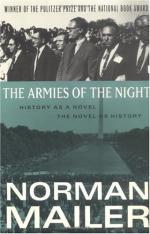|
This section contains 514 words (approx. 2 pages at 400 words per page) |

|
The Armies of the Night: History as a Novel, the Novel as History Summary & Study Guide Description
The Armies of the Night: History as a Novel, the Novel as History Summary & Study Guide includes comprehensive information and analysis to help you understand the book. This study guide contains the following sections:
This detailed literature summary also contains Topics for Discussion and a Free Quiz on The Armies of the Night: History as a Novel, the Novel as History by Norman Mailer.
Well-known writer Norman Mailer receives a phone call from an old acquaintance, Mitchell Goodman. Mitchell Goodman has become involved in the anti-war movement and is calling to request Mailer's support and presence at the March on the Pentagon. Mailer is annoyed at the interruption and unsure of how he feels about the protest, but he decides to leave New York and travel to Washington for the March.
At the March, Mailer meets up with many notable acquaintances, such as the poet Robert Lowell, critic Dwight Macdonald, parenting expert Dr. Spock, and linguist Noam Chomsky. On Thursday night, Mailer goes to a cocktail party before acting as Master of Ceremonies at an event at the Ambassador Theater. He drinks too much that night and wakes up Friday morning hungover.
On Friday, Mailer, Lowell, and Macdonald go to a meeting on a church lawn in Washington where young men have gathered to turn in their draft cards. William Sloane Coffin, Jr., chaplain at Yale, heads the walk over to the Department of Justice where 994 draft cards will be turned in to the government. There are many speeches and statements by the young men before Coffin goes into the Department of Justice. He returns some time later with the bag of draft cards; they have not been accepted by the authorities.
Saturday morning is the day of the March, and tens of thousands of people descend on the Washington Monument where they meet before walking to the Pentagon. Seeing the Lincoln Memorial and watching all the people gather to protest makes Mailer think of the Civil War and what it feels like to go into battle. He walks along with everyone else to the Pentagon and decides along the way that it is his duty to get arrested.
He crosses a military line to get arrested and is taken in a Volkswagen to a post office where he is held for several hours. In the Volkswagen on the way to the post office, Mailer gets into an altercation with a young blond man who wears a Nazi armband. An MP has to step in and get the men to calm down. He waits for several hours at the post office, hoping that he'll be let out in time to catch a plane back to New York because there's a party that night he wants to go to.
He is then taken to Occaquan, Virginia, where he spends the night in a jail before getting to see a judge. The judge gives him a harsher sentence than other protesters because he is older and more influential and should be a better example to young people, but the sentence is then shortened and he makes it back to New York by Sunday night.
The second half of the book is a history of the event, starting many months before the March with the planning process. The history covers the role of the media, the response by LBJ, the state of the liberal faction in America, and a harrowing conclusion regarding the future of American politics.
Read more from the Study Guide
|
This section contains 514 words (approx. 2 pages at 400 words per page) |

|



